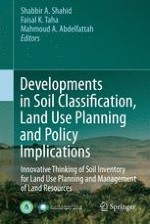2013 | OriginalPaper | Buchkapitel
31. Soil Use Planning and Decelerating Crop Productivities: Policy Implications for Indian Punjab
verfasst von : Davinder K. Grover
Erschienen in: Developments in Soil Classification, Land Use Planning and Policy Implications
Verlag: Springer Netherlands
Aktivieren Sie unsere intelligente Suche, um passende Fachinhalte oder Patente zu finden.
Wählen Sie Textabschnitte aus um mit Künstlicher Intelligenz passenden Patente zu finden. powered by
Markieren Sie Textabschnitte, um KI-gestützt weitere passende Inhalte zu finden. powered by
